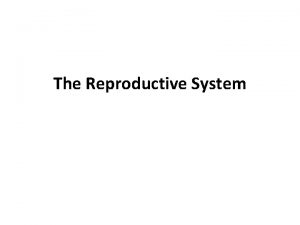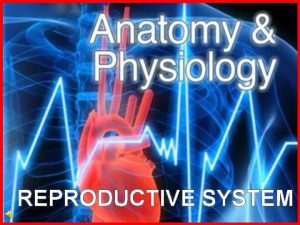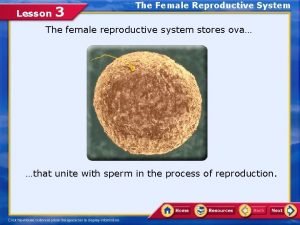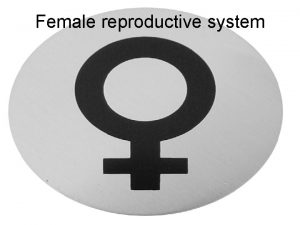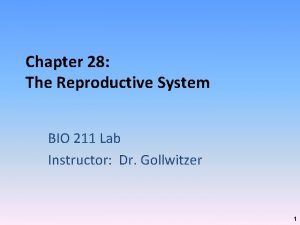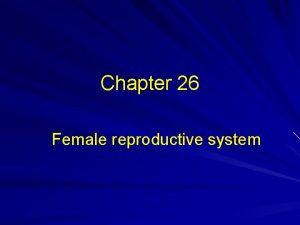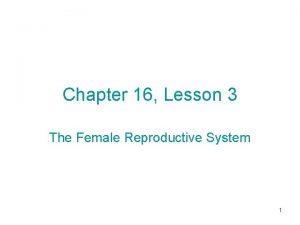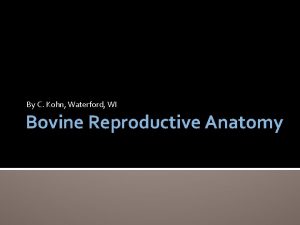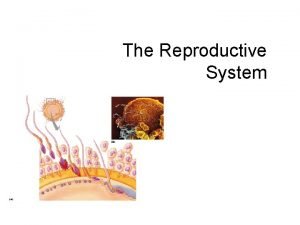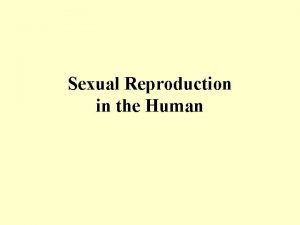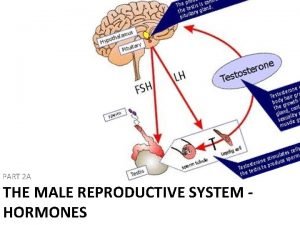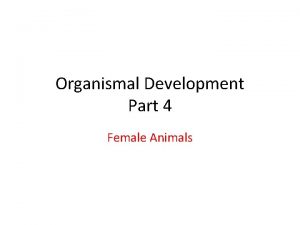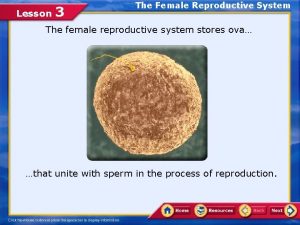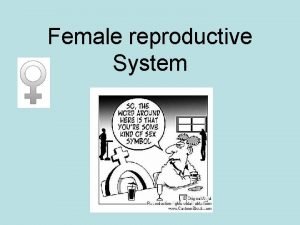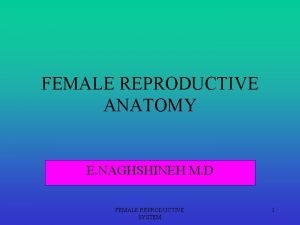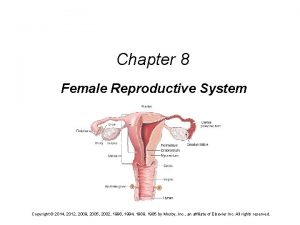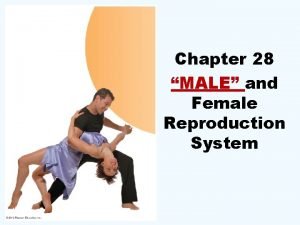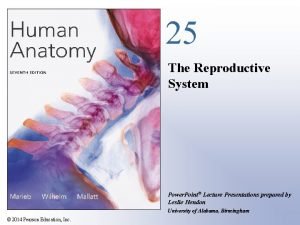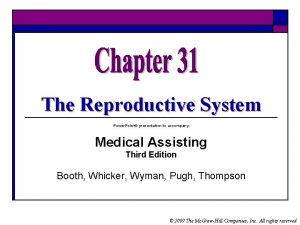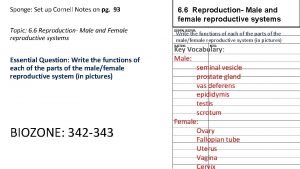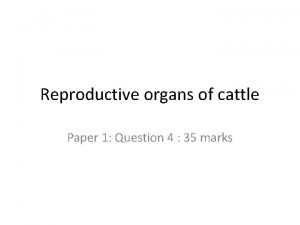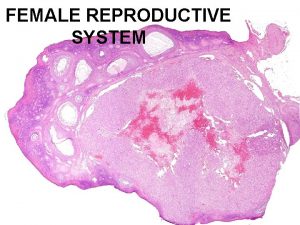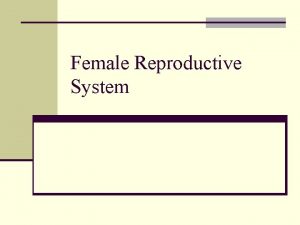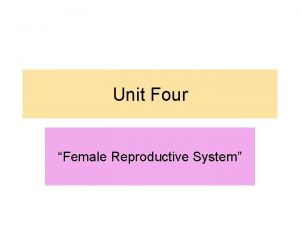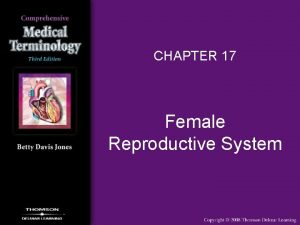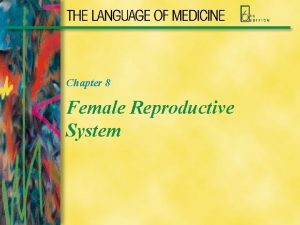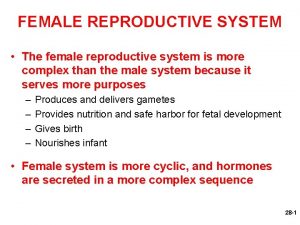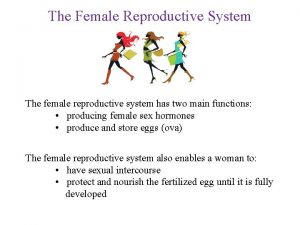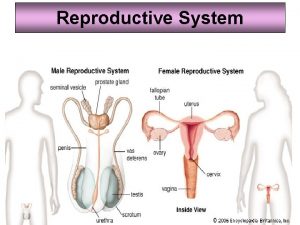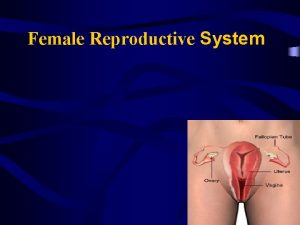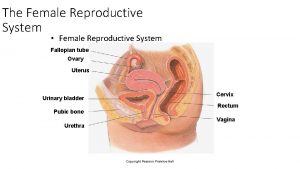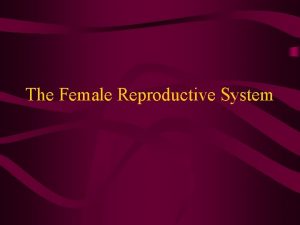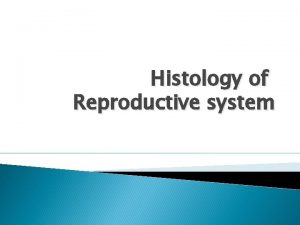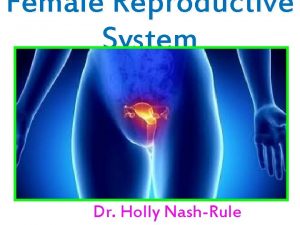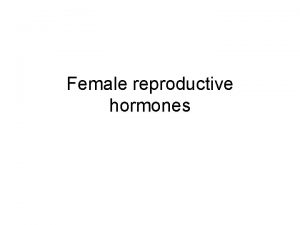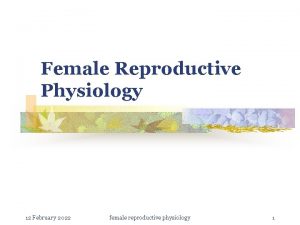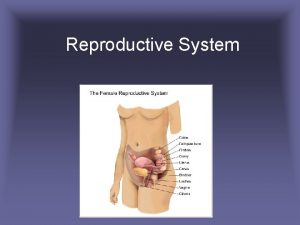The reproductive system I Female reproductive system Related































- Slides: 31

The reproductive system

I- Female reproductive system

Related terms Gynec/o women, female Cervic/o cervix-neck Colp/o vagina Hyster/o uterus Metr/o, metri/o uterus Uter/o uterus Lact/o milk

Men/o menses, menstruation My/o, myom/o muscle, muscle tumor Nat/I birth Obstetr/o pregnancy and child birth O/o egg Ovari/o ovary Ovul/o egg

Salping/o Mamm/o fallopian tubes breast Mast/o breast Vagin/o vagina Vulv/o vulva- Arche beginning (menarche the first period) Cyesis pregnancy

Endo within Intra within Primi first Retro backward

Gravida pregnant Parous bearing, bringing Rrhea discharge Multi many Nulli no, not, none Pre before Malacia softening

-gravida Pregnancy Nulligravida (never pregnant), primigravida (first-time pregnant), multigravida (many pregnancies) -para Live birth Nullipara (no live births), multipara (many live births) EXAMPLE: On an OB patient's chart you may see the abbreviations: gravida 3, para 2. This means three pregnancies, two live births. The OB patient, currently pregnant with her third baby, will become a Gravida 3, Para 3 after giving birth.

Endometriosis condition involving colonization a of the abdominal/pelvic cavity with islands of endometrial tissue. Endometrium is the lining layer of the uterus which sloughs off with each menstruation. If endometrial tissue flushes up the uterine tube and spills into the abdomen (peritoneal cavity), the clots of endometrial tissue can attach to abdominal organs such as the bladder, rectum, intestinal loops and then cycle along with the uterus in response to monthly changes in ovarian hormones. Bleeding into the abdomen irritates the lining membrane, the peritoneum, and causes abdominal pain.

Pelvic inflammatory disease (PID) Bacteria can make their way up the vagina, through the uterus, and traverse the uterine tubes which open into the abdominal cavity. Inflammation of the lining of the abdominal cavity, the peritoneum, causes abdominal pain. Chronic Inflammation of the uterine tubes can occlude them resulting in infertility.

Prolapsed uterus The uterus is almost directly above the vagina. In fact, the cervix, the neck region, of the uterus extends into the upper vagina. Ligaments hold the uterus in proper position so that it does not prolapse or herniate into the vagina. Severe prolapse can result in the uterine cervix protruding from the vaginal opening. Surgical repair is typically required to restore the uterus to its proper anatomical position.

Ectopic pregnancy Greek, "out of place“ A pregnancy implanted anywhere outside of the uterus. The uterine tube (Fallopian tube) is the most common location, also called a "tubal pregnancy". The abdominal cavity is the least common location. When it occurs, it is a surgical emergency, because the uterine tube cannot sustain tremendous expansion like the uterus. Eventually, the uterine tube will rupture with severe, possibly fatal, hemorrhaging.

Fraternal twins 2 infants born of the same pregnancy from 2 seperate ova fertilized by 2 different sperm Identical twins 2 infants resulting from division of 1 fertilized egg into 2 distinct embryos

Eclampsia ( toxemia of pregnancy ) A serious and life-threatening condition that may develop during pregnancy involving hypertension, convulsions and coma. A less severe form, preeclampsia, may develop but can be managed if identified and treated early.

Placenta previa Latin, "leading the way“ A placenta implanted over the cervical region of the uterus blocking the entrance to the birth canal. Occurs in less than one percent of pregnancies, but can cause significant bleeding and require a complicated delivery.

Obstetrician - literally "midwife" in Latin. A physician specializing in the diagnosis and management of pregnancy and delivering babies. Gynecologist - a physician specializing in diseases of the female reproductive system and surgery of this area. Most physicians currently specialize in combined practice of OB/GYN.

Hysterosalpingogram - special X-rays of the uterus and uterine tubes involving passing an opaque dye backwards up through the uterus to determine if the tubes are patent. Since the tubes are open into the abdominal (peritoneal) cavity, if patent, dye should spill out of the end of the tubes and be manifest on the X-ray.

Normal Menstruation typically begins when a girl is about 12 - 13 years old. The normal length of a menstrual cycle is 21 - 35 days, the average cycle being 28 days. Menstrual periods typically last 4 - 8 days, the average period lasting 6 days. Menopause usually occurs around the age of 51. Many women begin to experience symptoms when they are 40 - 44 years old.

Menstruation disorders Amenorrhea Absence of menstruation can be either primary or secondary. Primary amenorrhea is considered when a girl does not begin to menstruate by the age of 16. Secondary amenorrhea occurs when periods that were previously regular stop for at least three months.

Menstruation disorders Menorrhagia (metrorrhagia, or menometrorrhagia) Heavy bleeding includes prolonged menstrual periods or excessive bleeding.

Menstruation disorders Oligomenorrhea Light or infrequent menstruation refers to menstrual periods that occur more than 35 days apart. It usually is not a cause for concern, except if periods occur more than 3 months apart.

II- Male reproductive system

Andr/o male (androgen) Cry/o cold Crypt/o hidden epididym/o epididymis gon/o seed

one hormone -pexy fixation, put in place hydr/o water, fluid orch/o, orchid/o testis, testicle Balan/o Head of the penis Balanitis -genesis formation

prostat/o semin/I sperm/o, spermat/o test/o varic/o vas/o zo/o prostate gland semen, seed spermatozoa, semen testis, testicle varicose veins vessel, duct; vas deferens animal life

Sterilization Any procedure that removes an individual's ability to produce or release reproductive cells Hermaphroditism A condition where both ovarian and testicular tissue are found in the same individual.

Hypospadias - literally "below the fleshy spike. " A condition in which the external urinary meatus (opening) opens anywhere below the tip of the penis rather than at the tip. balanoplasty surgical repair of hypospadias using the foreskin of the head Hydrocele - a fluid filled sac partially surrounding the testis. Manifests itself as a swelling on the side of the scrotum. May cause discomfort. Can be surgically corrected.

Cryptorchidism is the absence of one or both testes from the scrotum. This usually represents failure of the testis to move, or "descend, " during fetal development from an abdominal position, through the inguinal canal, into the scrotum. Orchiopexy (or orchidopexy) is a surgery to move an undescended testicle into the scrotum and permanently fix it there.

Varicocele Dilated and twisted veins of the testis, sort of "hemorrhoids" of the scrotum! Manifests itself as a swelling on the side of the scrotum which may look and feel like a "bag of worms. " May be surgically corrected if causing discomfort. This condition may also cause reduced sperm count and male sterility due to sluggish blood flow elevating testicular temperature.

Benign prostatic hypertrophy (BPH) Swelling of the prostate gland which surrounds the base of the male bladder and urethra causing difficulty urinating, and nocturia Prostate Specific Antigen (PSA) PSA is a marker protein for prostate cell secretions which can be detected with a lab test. A rising PSA may be an early sign of prostate cancer, although there may be other causes including false positive tests

Abnormalities in semen analysis normozoospermia normal ejaculate. oligozoospermia sperm concentration fewer than 20 x 106/ml teratozoospermia fewer than 30% spermatozoa with normal morphology azoospermia no spermatozoa in the ejaculate aspermia no ejaculate
 Uterus sections
Uterus sections Development of female reproductive system
Development of female reproductive system Fetus reproductive system
Fetus reproductive system Ovarian ligament
Ovarian ligament Female reproductive system pregnancy
Female reproductive system pregnancy Parts of male and female reproductive system
Parts of male and female reproductive system Unit 5 lesson 3 the female reproductive system
Unit 5 lesson 3 the female reproductive system Ligaments of female reproductive system
Ligaments of female reproductive system Main function of female reproductive system
Main function of female reproductive system Female reproductive system of pila
Female reproductive system of pila Pig male reproductive system
Pig male reproductive system Figure 28-2 the female reproductive system
Figure 28-2 the female reproductive system Female reproductive organs sagittal section
Female reproductive organs sagittal section Chapter 16 the reproductive system answer key
Chapter 16 the reproductive system answer key Female cow reproductive system
Female cow reproductive system Horse reproductive system
Horse reproductive system Differences between male and female reproductive organ
Differences between male and female reproductive organ Sperm duct
Sperm duct Chapter 16 reproductive system
Chapter 16 reproductive system Female anatomy
Female anatomy Male reproductive system table
Male reproductive system table Female reproductive system diagram
Female reproductive system diagram Lesson 3 the female reproductive system
Lesson 3 the female reproductive system Female reproductive system colour
Female reproductive system colour Female anatomy diagram
Female anatomy diagram Chapter 8 female reproductive system
Chapter 8 female reproductive system 90/2
90/2 Conclusion of female reproductive system
Conclusion of female reproductive system Prostatic urethra male
Prostatic urethra male Female reproductive system pathology
Female reproductive system pathology Male reproductive system labeled
Male reproductive system labeled Cow reproductive anatomy
Cow reproductive anatomy


